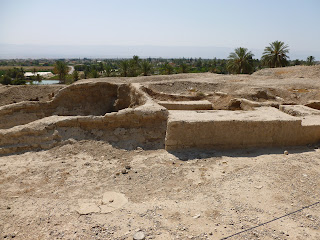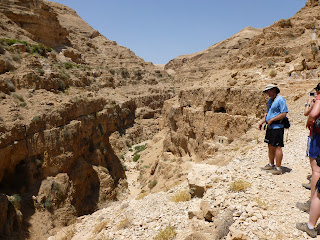I've not had the best internet access the last few days so I still need to go back and fill in Monday and Tuesday but wanted to get some more information up.
We are staying in a nice hotel (nicest place yet) right on the sea. Unfortunately the only place to get internet is inside the lobby, but I did go out wandering around the grounds some. The highlight so far is that this has the best shower of the trip so far - both hot water and water pressure. When you hike several miles a day and sweat so much your face is covered with salt a shower becomes the focus of the end of the day!
I did not get a picture of me fishing here yet, but I will.
We started the day with a hike across some fields in the area of Nazareth. We hiked up to the top of a low hill which turned out to be a rock quarry. John explained that while Joseph was described as a carpenter in most cases the original language of the bible was someone who builds things or works with his hands. There has been very little evidence of the use of wood in building things from his time. Perhaps short table legs but everything else is stone, rock, and pottery. So one school of thought is that he was a stone worker who would have known how to cut stone from a quarry. That means Jesus would have learned the same. Jesus did use stone in his parables, not wood which may support this idea. If that is the case then chances are they would have worked in the quarry we were in and may have helped build a palace used by Herod the great's grandson which was next to the quarry. There are documents which say that when that was built (early AD) that almost all stone cutters in the area were used to help build it. Even if not, Jesus would have seen the palace since it was just a few miles from Nazareth.
From here we traveled out to yet another mountain. As John quipped 'you have probably learned that when we park at the bottom of a hill, chances are we are going to climb it'. This was no exception. He said it would take about an hour but looking up at the steep cliffs and amount of height to climb I would have guessed 3 hours at least - but up we went. It was windy which was nice except when climbing near the edge of the trail when it almost felt we would be blown off the side. As far as I could tell we were the only ones climbing up. However it appeared to be a popular site for school tours as there were probably 200-300 school children we encountered in groups of 30 or so climbing down. It did not help that the first group we encountered within the first 5 minutes told us in broken English that the way was 'not good'. I guess the best way to describe it would be an hour and 1/2 of climbing stairs with stops about every 15 minutes so we could breath. There was a path, not man-made stairs, but they had cut steps of sort into the hill side. The reason we climbed the hill (small mountain) was that this was a common place for rabbis to come to pray and meet with disciples so it is likely that Jesus spent time on this spot and probably followed a similar trail if not the same. In fact, this was the location that the bible says he met with his disciples after he rose and it was from here that he told them to go and teach all nations and make disciples of them.
All along this trip it has been so invigorating not only in body and thought but also spiritually as we have gone to all of these places. And it seems that God also provides times for me to be able to take some time and meditate on what I've seen and read each day. Today as I was putting together this description a priest walked into the reception area dressed for mass to get a cork screw for the wine. I asked if he was getting ready to say mass and could I join them. He of course agreed but let me know it was going to be in German (third mass, third language for the trip). It was a great experience as we met in just a room with benches around the side and a table for the alter in the middle. They even had someone playing the guitar so they could sing. Many of the people spoke English very well and we chatted afterwards.
Tomorrow is supposed to be a very full day again with 5 biblical sites to visit but less hiking - or at least not as strenuous. I think today we walked 5 miles - most of it up hill.


































